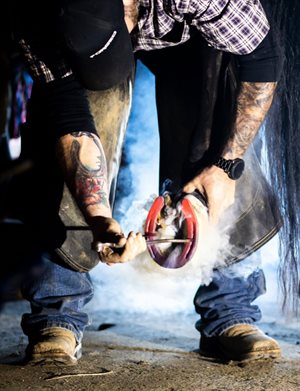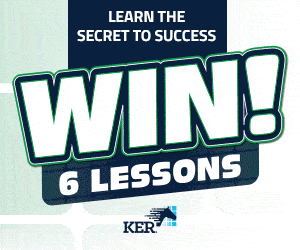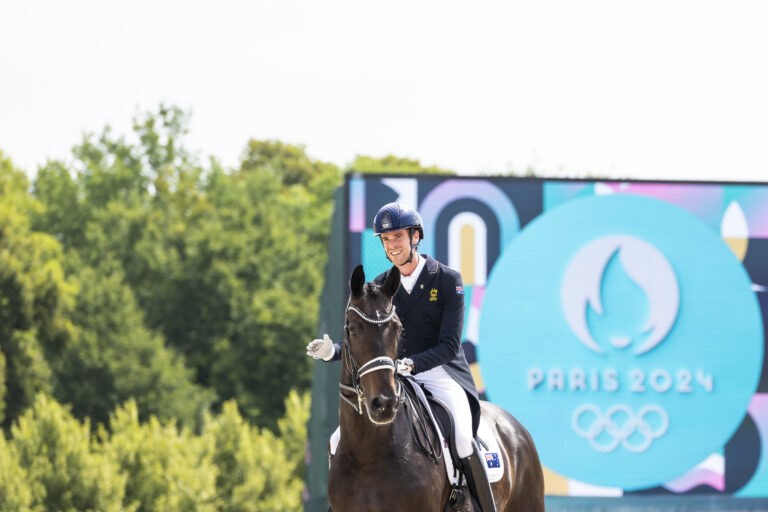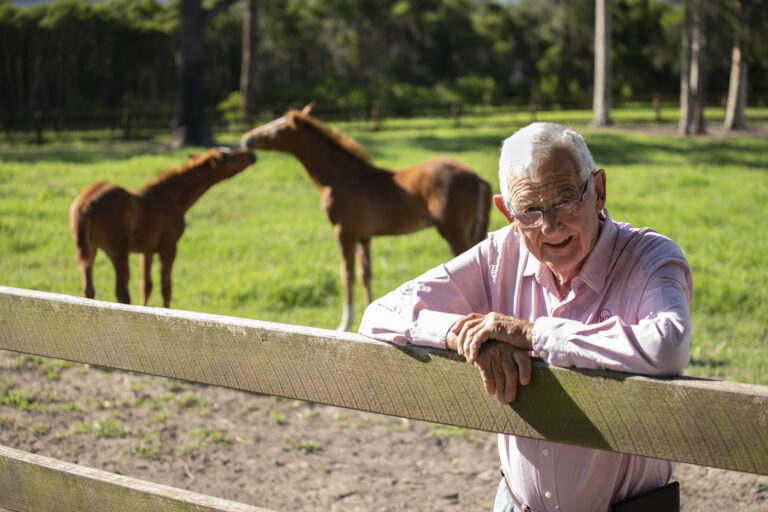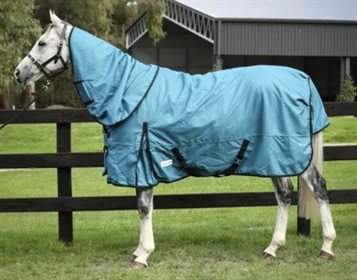There are three major constitutions that farriers must live by to do this right,
© Kimberly Dean
Words and photographs by Kimberly Dean
“I always wanted to be a cowboy, but becoming a farrier was as close as I could get,” said Brandon Amos.
As a Maryland-based farrier for the last 23 years, Brandon has forged enough steel to build a small ocean liner. Experience blended with his cowboy mentality “to get the job done right, sans ego,” positions him as not just a successful farrier but an ethical one.
When he started out as an apprentice decades ago, he truly loved horses and carried a natural desire to help them. At the time, he also loved the idea of a job outdoors, healthy paychecks and being placed in barns with lots of women his age. Such is often the drive for younger men pursuing this career. It’s all alluring…
But not all make it.
There are three major constitutions that farriers must live by to do this right, and Brandon identifies them one by one…
Constitution #1: Leave the Ego at the Barndoor
“You really need to check yourself at the barn door and walk in with an open mind and have nothing else on your mind except that horse,” he said.
Earlier on, Brandon’s ego nearly cost him his career; but, through some soul searching he salvaged it. That desire he once carried to be a cowboy stuck with him because a cowboy gets the job done right. Without an ego. Without boast.
Brandon warns that farriers shouldn’t be shoeing 12-15 horses a day and feeling good about those numbers.
“I used to pride myself on getting 15 horses done in a day. And you know what, looking back, those horses probably suffered because of that.”
The adage “quality over quantity” rings true with horse shoeing. Farriers must take the time to truly analyze the animals based on their conformation, and that process takes extra time and thought.
Which leads to the next constitution:
Constitution #2: Remember it’s ALWAYS About the Horse
Ensuring that the horse is always at the forefront of the job is to accept, even embrace, that farriers sometimes need to listen to those who know better than they do. Those who listen to vets, those who listen to owners and trainers, and those who are then able to construct a final plan based on all of that information are the ones truly keeping it about the horse.
It’s not always easy to have a vet tell you you’re wrong. Brandon can admit that, and he states that ALL farriers at some point will have their feelings hurt – or their ego tarnished – by a vet.
But, again, back to the EGO… it just needs to go because a sound horse often requites a team effort.
Vets, peers, trainers and horse owners all play a role in the ultimate soundness of a horse. Collaborating willingly and with an open mind only leads to further success for the horse and the farriers.
“Long gone are the days where we just trim the toe and just pull back the shoe,” says Brandon. “The first person I rode horses with, Mike Vannoy (a professional farrier), is my best friend to this day. He always let his work speak for him, and I envied that. Till I was in my 30s, I couldn’t do that. Now, I really pride myself on being able to communicate with the rider, trainer, and vet.”
Constitution #3: Stay Educated. Stay Challenged.
Recently, Brandon attended Grant Moon’s Clinic in the summer of 2019, which lasted three days. The attendance included an array of farriers ranging from decades of experience to those just starting out… both males and females.
What’s so important about these types of clinics is the opportunity for even the most experienced farriers to test and significantly enhance their skills. Mr. Moon is perhaps the most famous farrier in the world and travels globally to teach hands-on clinics.
Brandon stressed how critical his attendance at these types of clinics, as well as competing in shoeing competitions, have been for his mental drive as a farrier as well as his continued success. Just like a any trade or career, once a professional has been in it long enough, sometimes it’s easy to go “stale.” It’s paramount to continue learning, challenging and pushing oneself in order to provide these horses the best care. Brandon suggests aside from clinics and competitions, that farriers should consider going for their certification.
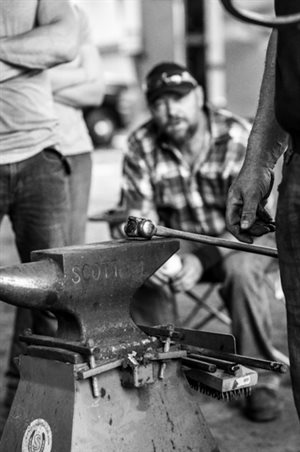
Stay educated, stay challenged
Kimberly Dean
Many journeyman farriers sustain their entire career without that national certification; however, taking the test with the American Farrier’s Association and adding that credential to shows a real drive and determination to stay fresh.
Whatever the outlet: clinics, competitions, certification tests… Brandon embraces them and encourages all farriers to do the same.
But what about the owners…?
Horse Owners Observing Farriers
When choosing a farrier based on reputation, which can include paying premium rates because a farrier is considered “the best,” Brandon encourages all owners to observe the following and take note that the farrier is in fact:
- Examining the conformation of the horse and balancing him based on that conformation.
- Attending workshops and or clinics each year held by other farriers or vets.
- Considering the vet, owner or trainer’s feedback without ego or pride stepping into the mix.
- Keeping appointments on the regular and not habitually cancelling.
All four points above mean that a farrier is likely a wonderful choice and cares about the animal above all else.
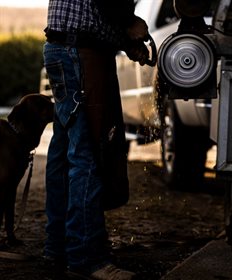
A sound horse requires team effort
© Kimberly Dean
Yet, not all owners have an opportunity to observe their farriers. Some board in large barns where management handles the shoeing and the visits. Yet, one of the issues here is that the owners who are riding their horses daily know better than anyone else what feels off or on when it comes to their own horse.
If a horse is in full training, that’s different and totally acceptable for a trainer to be handling the shoeing.
The point is, at the end of the day…
A Sound Horse Requires Team Effort
Vets, peers, trainers and horse owners all play a role in the ultimate soundness of a horse. Collaborating willingly and with an open mind only leads to further success for the horse.
Vets and farriers may not always agree, but the goal is to collaborate respectfully. Vets have tools and technology that farriers don’t and can uncover the causes of lameness by using that technology; thus when a vet presents a film or ultrasound uncovering an obvious cause of lameness, regardless of what the farrier thought he or she knew, that evidence must take priority for treatment.
Furthermore, if a vet thinks a farrier needs to trim a toe a certain way based on the x-ray, but that farrier strongly disagrees (perhaps that farrier knows of a new wedge or way to position a shoe that’s shown great success in similar cases), it’s up to the vet to also take that knowledge into consideration. Harmony between the expertise of vets and farriers isn’t always easy, but certainly achievable.
“There is no better feeling than when you’re working on a horse that needs help conformationally, or is sore from something, and you balance him or modify a shoe. When you put that hoof down, the horse starts licking and chewing, which tells you he’s happy with what you did. That makes the hair on my arms stand up.” – Brandon Amos
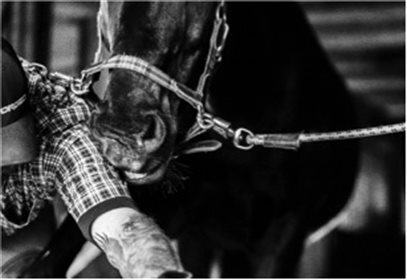
Vets and farriers may not always agree, but the goal is to collaborate respectfully
© Kimberly Dean
About the author:
Freelance writer and photographer Kimberly Dean lives in Baltimore County Maryland. Her warmblood, Bodie, brings her great joy as they train within the hunter discipline. She’s also the proud mom of a 21 year old off-track TB, Lucky, who she’s loved for 11 years.
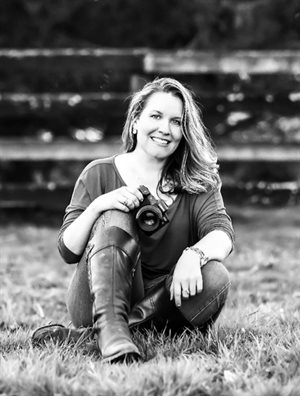
Freelance writer and photographer Kimberly Dean lives in Baltimore County Maryland
READ THE LATEST NEWS ARTICLES HERE

